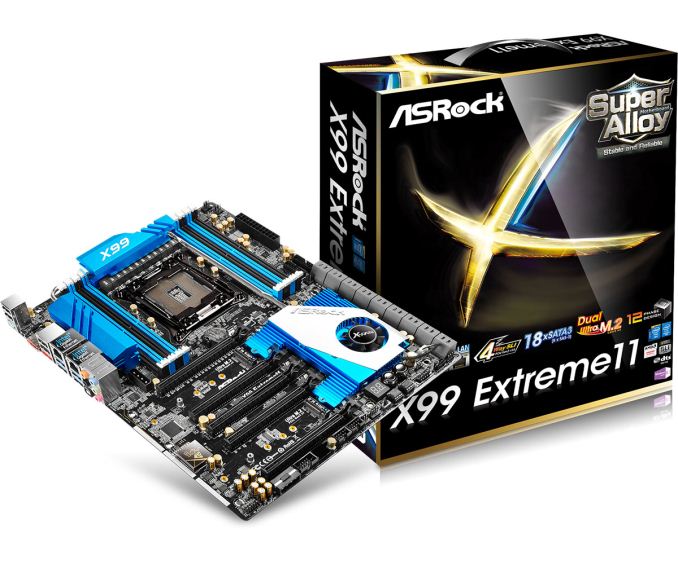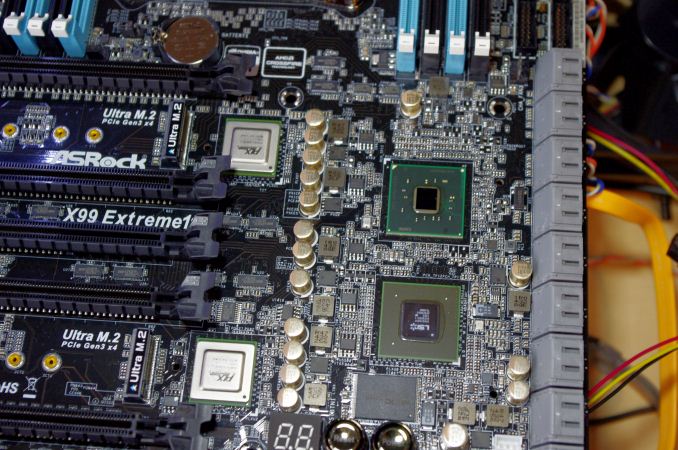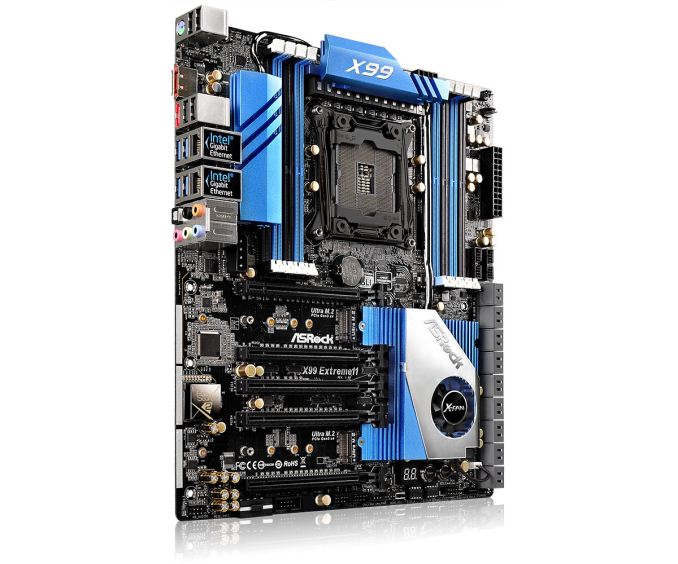The ASRock X99 Extreme11 Review: Eighteen SATA Ports with Haswell-E
by Ian Cutress on March 11, 2015 8:00 AM EST- Posted in
- Motherboards
- Storage
- ASRock
- X99
- LGA2011-3
The ASRock X99 Extreme11 Conclusion
There are particular areas of each electronics market that the general consumer doesn't see or might have difficulty understanding. If a general consumer is concerned primarily about cost, then seeing a market where money-is-no-object offers a strange perspective. Ultimately, the ASRock X99 Extreme11 is in one of these brackets. Most home users would agree that $600+ for a motherboard feels insane, but for the storage and compute markets to which it is focused, $600 can be a drop in the ocean of total system cost. It may even save a few $$$ if it has the required features already onboard.
The reason for the cost of the X99 Extreme11 stems from two PLX8747 PCIe 3.0 switches providing x16/x16/x16/x16 for four-way PCIe coprocessor action as well as an LSI 3008 SAS/SATA controller giving eight more storage ports. These eight ports combine with the ten from the chipset for a total of eighteen.
In the hierarchy of reasons to buy a motherboard, having a particular functionality rates high and it is the functionality that will cause users to buy the Extreme11, similar to the X99 WS-E/10G we reviewed previously. Alongside the to-buy features, the motherboard also comes with dual Intel network ports (I218-V and I211-AT), support for Intel Xeons and 128GB of RDIMMs and a boosted Realtek ALC1150 audio solution in the form of Purity Sound 2.
A key metric in our tests for such a board is power consumption, and given the extra components it perhaps comes as no surprise that under load the Extreme11 draws 244W at CPU load and comes in as nearly the most power hungry out of the X99 boards we have tested. The extra components pushes POST times nearer 25 seconds also. One surprising outcome was the PCH USB 3.0 speed, coming top in our test.
While the Extreme11 is not necessarily bought for performance, the base BIOS we tested with implemented a form of multi-core turbo, giving it high marks across almost all of our CPU suite. Overclocking performance on our mediocre CPU matched that of other X99 motherboards, with the range of automatic options providing suitable feedback to place a manual set of parameters.
In the past, I have always said that the first thing users consider when purchasing a motherboard is if it has a certain feature they need. (Next in the order of narrowing down the options, assuming no prior experience with a brand, is usually price, then looks, then performance, extras and support.) The ASRock X99 Extreme11 sits in that niche for users who want Haswell-E or Xeon E5 v3 as well as storage and multiple PCIe coprocessors - a niche with only few motherboardsin the self-build community, making the Extreme11 a straightforward option.













58 Comments
View All Comments
Vorl - Wednesday, March 11, 2015 - link
ahh, like I said, I might have missed something. Thanks!I was just looking at the haswell family and know it does support IGP. I didn't know that 2011/-E doesn't
yuhong - Saturday, March 14, 2015 - link
Yea, servers are where 2D graphics on a separate chip on the motherboard is still common.Kevin G - Wednesday, March 11, 2015 - link
Native PCIe SSDs or 10G Ethernet controllers would make good use of the PCIe slots.A PCIe slot will be necessary for graphics, at lest during first time setup. Socket 2011-3 chips don't have integrated graphics so it is necessary. (It is possible to setup everything headless but you'll be glad you have a GPU if anything goes wrong.)
As for why use the LSI controller, it is a decent HBA for software RAID like those used under ZFS. For FreeNAS/NAS4Free users, the numerous number of ports enables some rather larger arrays or features like hot sparing or SSD caching.
Vorl - Wednesday, March 11, 2015 - link
for 10G Ethernet controllers/Fiber HBAs you only need (need is such a strong word too, considering 10g ethernet, and 8gb fiber only need 3 and 2 lanes respectively for PCIe 2.0.) 8x slots. for super fast PCIe storage like SSDs you only need 4x slots which is still 2GB/s for PCIe 2.0 They would have been better served adding more PCIe 8x slots, but then again, what would be the point of 18 SATA slots if you were going to add storage controllers in the PCIe 16x slots?The 4x16 PCIE x16 slots makes me think compute server, but that doesn't mesh with 18 SATA ports. If the database engines were able to use graphics cards now (which I know is being worked on) this system might make more sense.
It still makes me think they just tried to slap a bunch of stuff together without any real thought about what the system would really be used for. I am all for goign fishing and seeing what people would use a board like this for, except that the $600 price tag put's it out of anyone but the most specialized use cases.
As for the LSI controller, like someone mentioned above, you can get a cheaper board with 8x sata PCIe cards to give you the same number of ports. More ports even since most boards these days come with 6x sata 6Gbs connections The 1mb of cache is so silly for the LSI chip that it's laughable.
The 128mb of cache for the RAID controller is a little better, but again, with just 6 RAID ports, what's the point?
The whole board is just a mess of confusion.
3DoubleD - Wednesday, March 11, 2015 - link
Similar to my thinking in my post above.If you are going for a software RAID setup with a ludicrous number of SATA ports, you can get a Z97 board with 3 full PCIe slots (x8,x8,x4) with 8 SATA ports. With three supermicro cards (two 8x SATAIII and one 8x SATAII because of the x4 PCIe slot) you would have 32 SATA ports and it would cost you $650. The software raid I use "only" accepts up to 25 drives, so that last card is only necessary if you need that 1 extra drive, so for $500 you could run a 24 drive array with a M.2 or SATA Express SSD for a cache/system drive. And as you pointed out, since it is Z97, it would have on board video.
Basically, given the price of these non-RAID add-in SATA cards, I'd say that any manufacturer making a marketing play on SATA ports needs to keep the cost of each additional SATA port to <$20/port over the price of a board with similar PCIe slot configurations.
As you said, if this board had 18 SATA ports that could support hardware RAID, then it would be worth the additional price tag. This is probably not possible though since 10 SATA ports are from the chipset and the rest from an additional controller. For massive hardware RAID setups your better off getting a PCIe 2.0 x16 card (for 16 SATAIII drives) or a PCIe 3.0 x16 card (if such a thing even exists, it could theoretically handle 32 SATAIII drives). I'm sure such large hardware RAID arrays become overwhelming for the controller and would cost a fortune.
Anyway, this must be some niche prosumer application that requires ludicrous amounts of non-RAID storage and 4 co-processor slots. I can't imagine what it is though.
Runiteshark - Wednesday, March 11, 2015 - link
No clue why they didn't do a LSI 3108 and have the port for the add on BBU and cache unit like Supermicro does on some of their boards. Also not sure why these companies can't put 10g copper connectors at minimum on these boards. Again, supermicro does it without issue.DanNeely - Wednesday, March 11, 2015 - link
There're people who think combining their gaming godbox and blueray rip mega storage box into a single computer is a good idea. They're the potential market for a monstrosity like this.You know what they say, "A fool and his money will probably make someone else rich."
Murloc - Wednesday, March 11, 2015 - link
I guess this is aimed at the rather unlikely situation of someone wanting both storage and computation/gaming in the same place.You know, there are people out there who just want the best and don't care about wasting money on features they don't need.
Zak - Thursday, March 12, 2015 - link
I agree. For reasons Vorl mentioned this is a pointless board. I can't imagine a target market for this. My first reaction was also, wow, beastly storage server. But then yeah, different controllers. What is the point?eanazag - Thursday, March 12, 2015 - link
It is not a server board. Haswell-E desktop board. I have no use for that many SATA ports but someone might.2 x DVD or BD drives
2 x SSDs on RAID 1 for boot
Use Windows to mirror the two below RAID 0 volumes.
7 x SSDs in RAID 0
7 x SSDs in RAID 0
The mirrored RAID 0 volumes could get you about 3-6 GBps transfer rates on reads from a 400 MBps SSD in sequential read. Maybe a little less in write speeds. All done with mediocre SSDs.
This machine would cost over $2000.